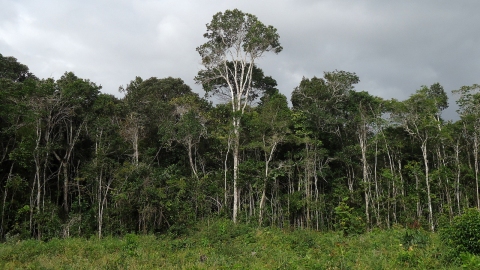Tabebuia stenocalyx
Sprague & Stapf
Bignoniaceae
Common Name: Palo Blanco
General Information
Tabebuia stenocalyx is a deciduous tree usually growing 8- 25 metres tall, but with reports of trees up to 45 metres tall. The straight, cylindrical bole often has low buttresses and can be up to 90cm in diameter[
378- Title
- Present and Potential Commercial Timbers of the Caribbean
- Publication
- USDA Agricultural Handbook No. 207
- Author
- Longwood.F.R.
- Publisher
- USDA Forest Service; Washington, DC.
- Year
- 1962
- ISBN
-
- Description
- Quite detailed information on more than 60 species of Caribbean timber trees, giving species descriptions, habitat, detailed info on the wood and some info on other uses. Available for download on the internet.
,
2095- Title
- Bignoniaceae: Part II (Tribe Tecomeae)
- Publication
- Flora Neotropica Monograph Vol. 25, No. 2 pp 1-370
- Author
- Gentry A.H.
- Publisher
- The New York Botanical Garden, New York
- Year
- 1992
- ISBN
- 0-89327-368-6
- Description
-
].
The tree is harvested from the wild for its timber.
Known Hazards
None known
Botanical References
2095- Title
- Bignoniaceae: Part II (Tribe Tecomeae)
- Publication
- Flora Neotropica Monograph Vol. 25, No. 2 pp 1-370
- Author
- Gentry A.H.
- Publisher
- The New York Botanical Garden, New York
- Year
- 1992
- ISBN
- 0-89327-368-6
- Description
-
Range
S. America - Brazil, Venezuela, the Guyanas; Caribbean - Trinidad and Tobago.
Habitat
Often found in swampy areas; at elevations up to 500 metres[
2095- Title
- Bignoniaceae: Part II (Tribe Tecomeae)
- Publication
- Flora Neotropica Monograph Vol. 25, No. 2 pp 1-370
- Author
- Gentry A.H.
- Publisher
- The New York Botanical Garden, New York
- Year
- 1992
- ISBN
- 0-89327-368-6
- Description
-
].
Properties
| Other Uses Rating |      |
| Habit | Deciduous Tree |
| Height | 20.00 m |
| Pollinators | Hawk moths |
| Cultivation Status | Wild |
Cultivation Details
Not known
Edible Uses
None known
Medicinal
None known
Other Uses
The heartwood is variously described as creamy, yellowish, or greyish brown or sometimes brownish, often with dark flecks showing on the surface; it is not clearly differentiated from the lighter coloured sapwood[
378- Title
- Present and Potential Commercial Timbers of the Caribbean
- Publication
- USDA Agricultural Handbook No. 207
- Author
- Longwood.F.R.
- Publisher
- USDA Forest Service; Washington, DC.
- Year
- 1962
- ISBN
-
- Description
- Quite detailed information on more than 60 species of Caribbean timber trees, giving species descriptions, habitat, detailed info on the wood and some info on other uses. Available for download on the internet.
]. The texture is medium; the grain fairly straight; the lustre moderately high; without distinctive odour or taste; and without the yellow powder (lapachon) found in other species in the lapachon group of Tabebuia[
378- Title
- Present and Potential Commercial Timbers of the Caribbean
- Publication
- USDA Agricultural Handbook No. 207
- Author
- Longwood.F.R.
- Publisher
- USDA Forest Service; Washington, DC.
- Year
- 1962
- ISBN
-
- Description
- Quite detailed information on more than 60 species of Caribbean timber trees, giving species descriptions, habitat, detailed info on the wood and some info on other uses. Available for download on the internet.
]. The wood is of medium weight, moderately hard, firm, strong and resilient but not very durable[
378- Title
- Present and Potential Commercial Timbers of the Caribbean
- Publication
- USDA Agricultural Handbook No. 207
- Author
- Longwood.F.R.
- Publisher
- USDA Forest Service; Washington, DC.
- Year
- 1962
- ISBN
-
- Description
- Quite detailed information on more than 60 species of Caribbean timber trees, giving species descriptions, habitat, detailed info on the wood and some info on other uses. Available for download on the internet.
]. Logs are reported to spring badly during conversion; dry lumber saws, planes, shapes, bores, mortises, and sands easily with smooth clean edges in all operations. It finishes and polishes very smoothly with a glossy finish[
378- Title
- Present and Potential Commercial Timbers of the Caribbean
- Publication
- USDA Agricultural Handbook No. 207
- Author
- Longwood.F.R.
- Publisher
- USDA Forest Service; Washington, DC.
- Year
- 1962
- ISBN
-
- Description
- Quite detailed information on more than 60 species of Caribbean timber trees, giving species descriptions, habitat, detailed info on the wood and some info on other uses. Available for download on the internet.
]. The wood is well suited for use in tool handles and for boat decking and boat parts, where high resistance to decay is not essential. It is used extensively for furniture, flooring, interior house trim, building construction, and general carpentry. In the areas where it grows it is also used for paddles and packing cases. On the basis of its qualities, this timber could be substituted for ash in sporting goods, agricultural implements, and possibly for decorative veneer[
378- Title
- Present and Potential Commercial Timbers of the Caribbean
- Publication
- USDA Agricultural Handbook No. 207
- Author
- Longwood.F.R.
- Publisher
- USDA Forest Service; Washington, DC.
- Year
- 1962
- ISBN
-
- Description
- Quite detailed information on more than 60 species of Caribbean timber trees, giving species descriptions, habitat, detailed info on the wood and some info on other uses. Available for download on the internet.
].
Propagation
Seed -
If you have any useful information about this plant, please leave a comment. Comments have to be approved before they are shown here.







 Useful Tropical Plants Database 2014 by
Ken Fern,
web interface by
Ajna Fern
with help from
Richard Morris.
Useful Tropical Plants Database 2014 by
Ken Fern,
web interface by
Ajna Fern
with help from
Richard Morris.